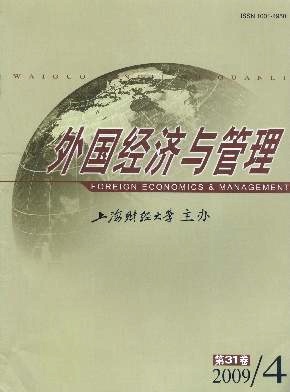基于哲学视角的组织隐喻研究前沿探析
外国经济与管理 2009 年 第 31 卷第 04 期, 页码:1 - 9
摘要
参考文献
摘要
在组织理论研究中,我们常用形象的语言来隐喻地说明组织及其结构的本质或现象。组织隐喻可以说是人类表象思维的一种集中体现,它是向概念思维演化的一个关键阶段。本文从组织隐喻的本体论、认识论和方法论视角讨论了组织隐喻问题,认为组织及其管理的理论和实践从本质上是由隐喻所支配、控制的,隐喻深刻地影响着我们对组织及其管理的看法和组织理论研究的方式、方法和路径选择。
[1]Gareth Morgan.I mages of organizations[M].Beverly Hills,California:Sage Publications,1986.
[2]James R Taylor.Shifting froma heteronomous to an autonomous worldviewof organizational communication:Communication theoryon the cusp[J].Communication Theory,1995,5(1):1-35.
[3]WilliamP Foster.Paradigmand promises:Newapproaches to educational administration[M].New York:Prometheus Books,1986.
[4]Karl E Weick.The social psychology of organizing(Topics in social psychology series)[M].(2nd Ed.).New York:Random House,1979.
[5]William P Foster.A critical perspective on administration and organization in education[A].in Kenneth A Sirotnik,and JeannieOakes(Eds.).Critical perspectives on the organization andi mprovement of schooling[C].Boston:Kluwer-Nijhoff Publishing,1986:107-111.
[6]James R Taylor,Fran ois Cooren,Nicole Giroux,and Daniel Robichaud.The communicational basis of organization:Between theconversation and the text[J].Communication Theory,1996,6(1):1-39.
[7]Ruth C Smith.I mages of organizational communication:Root-metaphors of the organization-communication relation[R].Paper pres-ented at the Meeting of the International Communication Association Annual Conference,Washington DC,1992.
[8]Daniel A Wren.Interface andinterorganizational coordination[J].Academy of Management Journal,1967,10(1):69-81.
[9]Dennis K Mumby,and Robin P Clair.Organizational discourse[A].in Teun Avan Dijk(Ed.).Discourse as structure and process:Discourse studies(Vol.II)[C].London:Sage Publications,1997:181-201.
[10]David Grant,Tom Keenoy,and Cliff Oswick.Organizational discourse:Of diversity,dichotomy,and multidisciplinarity[A].in Da-vid Grant,Tom Keenoy,and Cliff Oswick(Eds.).Discourse and organization[C].London:Sage Publications,1998.
[11]Gerrit Broekstra.An organisationis a conversation[A].in David Grant,Tom Keenoy,and Cliff Oswick(Eds.).Discourse and or-ganization[C].London:Sage Publications,1998.
[12]Eric MEisenberg,and H Lloyd Goodall,Jr.Organizational communication:Balancing creativity and constraint[M].Boston:Bed-ford/St Martins Di mensions,2004.
[13]Karl E Weick.Management of organizational change amongloosely coupled elements[A].in P S Goodman(Ed.).Changein organi-zations:New perspectives on theory research and practice[C].San Francisco:Jossey-Bass,1982.
[14]Douglas J Orton,and Karl E Weick.Loosely coupled systems:Areconceptualization[J].Academy of Management Review,1990,15(2):203-223.
[15]Linda Smircich.Concept of culture and organizational analysis[J].Administrative Science Quarterly,1983,28(3):120-131.
[16]Ikujiro Nonaka.The knowledge creating company[J].Harvard Business Review,l991,69(11/12):96-104.
[17]Richard Gallagher,and Ti m Appenzeller.Beyond reductionism[J].Science,1999,284(2):79-91.
[18]TomJ Peters.Liberation management:Necessary disorganization for the nanosecond nineties[M].New York:Alfred P Knopf,1992.
[19]William P Barnett,and Glenn R Carroll.Modelinginternal organizational change[J].Annual Review of Sociology,1995,21(3):217-236.
[20]James D Thompson.Organizationin action:Social science bases of administrative theory[M].New York:Transaction Publishing,2003.
①所谓“本体”(onto),是指终极的存在,也就是表示事物内部根本属性、质的规定性和本原,与“现象”相对应。许多哲学家认为,本体即超越性存在。对于这种超越性存在,人是无法感性直观地把握的。而本体论作为一个哲学范畴,意指关于存在、存在物的学说。或者说,本体论就是对本体加以描述的理论体系,即是指构造终极存在的体系。本体论的一个重要特点就是自我相关性,即人本身就在这本体之中,本体论就在其所描述的本体之中。
②有关复杂性理论和混沌理论的相似性和差异性问题一直存在着激烈的争论,John Horgen建议用一个新词“混沌复杂”(chaoplexity)来突出两者在概念上的交叠。参见John Horgen.The end of science:Facingtheli mits of knowledgeinthe twilight of scientific age[M].Reading,MA:Helix Books,1996:191。
③事实上,Chester I.Barnard也表达了与Karl E.Weick所说的松散耦合属性相类似的观点。Barnard指出,如果一个组织体系的组成部分很多、很大,那么,它们就势必会组成一些次级的或局部的体系。“在这种情况下,每一个局部体系的各个部分之间形成自己的关系,这些关系可以演化出局部体系的一种新的状态,但并不以显著的方式改变整个体系。”参见Chester I.Barnard.The function of theexecutive[M].Cambridge,MA:Harvard University Press,1958:72。
[2]James R Taylor.Shifting froma heteronomous to an autonomous worldviewof organizational communication:Communication theoryon the cusp[J].Communication Theory,1995,5(1):1-35.
[3]WilliamP Foster.Paradigmand promises:Newapproaches to educational administration[M].New York:Prometheus Books,1986.
[4]Karl E Weick.The social psychology of organizing(Topics in social psychology series)[M].(2nd Ed.).New York:Random House,1979.
[5]William P Foster.A critical perspective on administration and organization in education[A].in Kenneth A Sirotnik,and JeannieOakes(Eds.).Critical perspectives on the organization andi mprovement of schooling[C].Boston:Kluwer-Nijhoff Publishing,1986:107-111.
[6]James R Taylor,Fran ois Cooren,Nicole Giroux,and Daniel Robichaud.The communicational basis of organization:Between theconversation and the text[J].Communication Theory,1996,6(1):1-39.
[7]Ruth C Smith.I mages of organizational communication:Root-metaphors of the organization-communication relation[R].Paper pres-ented at the Meeting of the International Communication Association Annual Conference,Washington DC,1992.
[8]Daniel A Wren.Interface andinterorganizational coordination[J].Academy of Management Journal,1967,10(1):69-81.
[9]Dennis K Mumby,and Robin P Clair.Organizational discourse[A].in Teun Avan Dijk(Ed.).Discourse as structure and process:Discourse studies(Vol.II)[C].London:Sage Publications,1997:181-201.
[10]David Grant,Tom Keenoy,and Cliff Oswick.Organizational discourse:Of diversity,dichotomy,and multidisciplinarity[A].in Da-vid Grant,Tom Keenoy,and Cliff Oswick(Eds.).Discourse and organization[C].London:Sage Publications,1998.
[11]Gerrit Broekstra.An organisationis a conversation[A].in David Grant,Tom Keenoy,and Cliff Oswick(Eds.).Discourse and or-ganization[C].London:Sage Publications,1998.
[12]Eric MEisenberg,and H Lloyd Goodall,Jr.Organizational communication:Balancing creativity and constraint[M].Boston:Bed-ford/St Martins Di mensions,2004.
[13]Karl E Weick.Management of organizational change amongloosely coupled elements[A].in P S Goodman(Ed.).Changein organi-zations:New perspectives on theory research and practice[C].San Francisco:Jossey-Bass,1982.
[14]Douglas J Orton,and Karl E Weick.Loosely coupled systems:Areconceptualization[J].Academy of Management Review,1990,15(2):203-223.
[15]Linda Smircich.Concept of culture and organizational analysis[J].Administrative Science Quarterly,1983,28(3):120-131.
[16]Ikujiro Nonaka.The knowledge creating company[J].Harvard Business Review,l991,69(11/12):96-104.
[17]Richard Gallagher,and Ti m Appenzeller.Beyond reductionism[J].Science,1999,284(2):79-91.
[18]TomJ Peters.Liberation management:Necessary disorganization for the nanosecond nineties[M].New York:Alfred P Knopf,1992.
[19]William P Barnett,and Glenn R Carroll.Modelinginternal organizational change[J].Annual Review of Sociology,1995,21(3):217-236.
[20]James D Thompson.Organizationin action:Social science bases of administrative theory[M].New York:Transaction Publishing,2003.
①所谓“本体”(onto),是指终极的存在,也就是表示事物内部根本属性、质的规定性和本原,与“现象”相对应。许多哲学家认为,本体即超越性存在。对于这种超越性存在,人是无法感性直观地把握的。而本体论作为一个哲学范畴,意指关于存在、存在物的学说。或者说,本体论就是对本体加以描述的理论体系,即是指构造终极存在的体系。本体论的一个重要特点就是自我相关性,即人本身就在这本体之中,本体论就在其所描述的本体之中。
②有关复杂性理论和混沌理论的相似性和差异性问题一直存在着激烈的争论,John Horgen建议用一个新词“混沌复杂”(chaoplexity)来突出两者在概念上的交叠。参见John Horgen.The end of science:Facingtheli mits of knowledgeinthe twilight of scientific age[M].Reading,MA:Helix Books,1996:191。
③事实上,Chester I.Barnard也表达了与Karl E.Weick所说的松散耦合属性相类似的观点。Barnard指出,如果一个组织体系的组成部分很多、很大,那么,它们就势必会组成一些次级的或局部的体系。“在这种情况下,每一个局部体系的各个部分之间形成自己的关系,这些关系可以演化出局部体系的一种新的状态,但并不以显著的方式改变整个体系。”参见Chester I.Barnard.The function of theexecutive[M].Cambridge,MA:Harvard University Press,1958:72。
引用本文
罗珉. 基于哲学视角的组织隐喻研究前沿探析[J]. 外国经济与管理, 2009, 31(4): 1–9.
导出参考文献,格式为:





 6762
6762  602
602

